Parmigiano-Reggiano (pahr-mih-JOHN-o red-gee-YAH-no), properly called “The King of Cheeses” in Italy and prosaically called parmesan in this country, is a magical cheese. Dotted with crunchy crystals and permeated with the mysterious flavor enhancer, umami, it barely resembles the cheap American imitator in the toilet paper tube labeled parmesan which often has wood cellulose added to it to make it fluffier.
The real stuff comes only from dairies in the fertile Po River Valley in the Emilia-Romagna and Lombardia regions of northern Italy around the towns of Parma, Reggio-Emilia, Modena, Bologna, and Mantova.
At about 12 months old, the minimum allowed by law, this medium-fat semi-hard to hard cheese is pale colored, noticeably but not overly salty, with a little sharp acidity, and a mildly nutty nose. It is never pungent or stinky.
A major part of its charm is its unique dual texture, both creamy and grainy (grana) at the same time, like a bass fiddle with piano duet. The flesh practically melts in your mouth leaving behind craggy granules. If you look at it closely you can see why: An occasional jewel-like glistening crystal of an amino acid called tyrosine.

Parmigiano-Reggiano is also high in other amino acids called glutamates, which create a rich flavor called umami, a Japanese word that translates loosely to a “savory deliciousness”. Japanese chefs and scientists first identified the taste phenomenon and the fact that our tongues seem to have specialized receptors for umami, and they tell us that the foods highest in umami are meats, mushrooms, soy sauce, and Parmigiano-Reggiano. Bottom line: The flavor of Parmigiano-Reggiano is explosive, expansive, and lingering.
It cracks, crumbles, and flakes, shaves and grates easily. Not surprisingly, it is commonly grated onto pastas where it melts easily. When broiled or baked Parmigiano-Reggiano has an incredible nuttiness to accompany the endlessly fascinating texture which is grainy when raw, chewy when warm, and crunchy crisp when melted and cooled.
Because it is relatively low fat, it ages well. As it ages up to 36 months, it gets tan and then amber, concentrates in flavor, gets slightly sweeter, becomes more powerful and complex, and develops more crystals while maintaining a butterscotch-like creaminess at the same time. As it ages the natural uncoated rind gets rock hard. When young it can sell for $12-20 per pound. Older cheeses can run up to $30.
How it is made
Each wheel is hand-crafted pretty much the same way it has been made for more than 800 years, now under the watchful eye of the Consorzio del Formaggio Parmigiano-Reggiano, the official regulatory and promotional agency. Alas, American parmesan bears little resemblance to the real deal and legally cannot be called Parmigiano, but more on that later.

The process of making Parmigiano-Reggiano is almost identical at the 450 dairies throughout the region. It evolved at the monasteries and castles in the 1200s. The large flat fields of grass in the region were perfect for grazing cattle for meat, milk, and butter. The salt came from the village of Salsomaggiore, about 12 miles (20 kilometers) from Parma. Before refrigeration, salt was an important preservative for meat, and, as it turned out, for cheese. The cheese that the local monks developed was especially prized because it could be kept for years at cellar temperature. A good thing, because refrigeration wasn’t invented for another 400 years.
Today, the process begins in the fields where the cattle graze only on grass and hay. No silage is allowed. The farmers disdain feed kept in silos because preservatives must be added to prevent mold, and they feel this affects the taste of the milk, not to mention it would prevent them from calling the cheese 100% natural. After they are milked, the rich liquid is left unpasteurized leaving the microbes in them alive, another important influence on the final product. The last batch of milk arrives at the dairy (caseificio) late in the afternoon where it is kept cool and left to settle overnight. The cheesemaker (casaro) arrives early the next morning to greet the fresh milk as it arrives and to skim the cream off the milk from yesterday.
About 172 gallons of fresh milk is mixed with a like amount of the skimmed milk in a steam-jacketed, copper-lined, flat-bottomed, sloped sided cauldrons (calderoni or caldaie) and the mix is warmed to about 91°F (33°C). Then they add bacteria rich whey starter culture from yesterday’s cheesemaking, and rennet, curdled milk from the stomach of an unweaned calf containing the enzyme rennin. Within 10 minutes the milk begins to curdle and separate into lumpy curds and thin yellowish watery whey. The casaro reaches in and feels the mix, running it through his fingers, rubbing it with his finger tips, and when it feels right, he breaks up the curds with a wire ball about twice the size of a basketball on a stick releasing more whey. The curds are now about the size and feel of warm white rice, and the mix is then cranked up to about 131°F (55°C) and stirred rapidly with something that looks like a large outboard motor. All through the process the cesaro watches closely and feels and tastes the curds. When it’s right, the stirring stops and it is allowed to rest for about an hour. The curds sink and the whey rises.
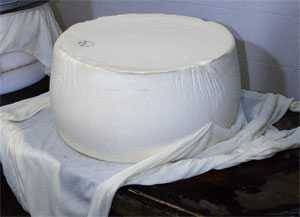
When things have have separated, and the curds congealed into one thick mass at the tapered bottom of the vat, the casaro uses a paddle to pry it from the bottom of the vat and lift it to the surface of the yellowish whey and, with the help of an assistant, gathers it into a ball in cheesecloth. It is shiny white, about the consistency of bread dough, looks a lot like a giant ball of fresh mozzarella, and weighs close to 200 pounds. It is then cut in half and each of the “twins” is hung above the vat in cheesecloth slings to drain for about 15 minutes.
The whey, about 300 gallons of it, is drained away and some is used for making ricotta cheese and some is sold to farmers who feed it to hogs for Prosciutto di Parma, the famous cured ham made nearby. The cream that is skimmed from the cheese is churned into butter.
Still in the cloth, the fresh cheese balls are placed into molds. A weight is placed on top of each ball and it is left to drain for two more hours. The molds are flipped, and after two hours flipped again. The cloth is then removed, the cheese is then placed into stainless steel molds lined with belts that have the distinctive pin-dot brand “Parmigiano-Reggiano” and the date on them.
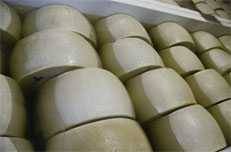
After two more days of drying, the wheels of cheese, now flat on top and bottom, are immersed in a 26% brine for about three weeks. The salt migrates about 1/4″ into the cheese and more moisture exits. This salt is the only legal additive.

Then the wheels are off to the aging room where, now down to about 86 pounds, they are placed on wooden shelves for aging. During this aging, the salt migrates evenly throughout the wheel, and many changes occur to the flavor and texture. The temperature is kept to about 61F (about 16C) and 80% humidity. These astounding cathedrals of cheese house thousands of golden wheels rising up to the high ceilings and the perfume of milk wafts through the air.
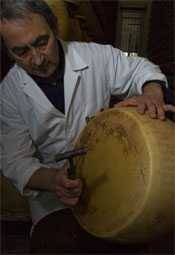
In the first two weeks the wheels are flipped every few days, and while the rinds are still soft, the edges are smoothed. After that the wheels and shelves are brushed clean and flipped every seven days. Only a few dairies still do it by hand, while most have “modernized” and use an elaborate machine for this tedious and backbreaking task.
After a year an inspector from the Consorzio tests every wheel by thumping it all over with a small metal hammer. He can tell by the sound if it is cracked or if there is an air bubble, and if there is a defect, the wheel is stripped of the official markings and usually sold to factories for grinding.
If the wheel passes it gets the Consorzio stamp of approval. It can either be packaged for sale or aged further. At its minimum age of 12-18 months it is called mezzano. At its most common age of 18-24 months it is called vecchio. The more rare 24-36 months of age it is called stravecchio or extravecchio, and occasionally a few producers sell cheese up to 48 months old. By the time you get it and the dehydration has finished, it has taken two gallons of milk to make one pound of cheese. There are about three million wheels of Parmigiano-Reggiano and four million wheels of it’s cousin, Grana Padano, made each year.
Accept no substitutes
There are many cheeses made around the world similar to, but not equal to P-R:
American Parmesan. American parmesan is made in a similar fashion, and the best can be very nice, but the subtle production differences are almost always easy to discern in the mouth. It begins with the cattle, which usually dine on specially formulated feed. The milk is pasteurized, which helps prevent disasters, but also impacts the flavor. Non-animal rennet is usually used, as well as store-bought starter cultures rather than whey from yesterday’s cheesemaking. The curds are broken by machine, leaving larger curds that are more moist. Domestic wheels are smaller which often produces saltier cheese. They can be aged for as little as six months so full flavor has not had time to develop. The result is a texture that is usually drier, rubbery, and without the crunch of the original. And they are blander. But the greatest difference is in the pre-grated stuff which can have cellulose added to keep it from clumping.
Grana Padano. Here is one imitator worth noting. Grana Padano is made just to the north of Parmigiano-Reggiano. Grana Padano’s production process is similar, but slightly different. Cattle can be fed silage, not just grass and hay, the milk does not have to be as fresh, and it contains less fat. It can be sold as young as nine months and is rarely aged beyond 24 months.
Black Wax Parmesan from Argentina. This is a lovely creamy nutty cheese that grates well, but is not very much like Parmigiano-Reggiano. It lacks the graininess, is not as salty, and has a wax rind, not a natural cheese rind.
Buying Parmigiano-Reggiano
Better groceries, gourmet stores, and cheese shops will carry real Parmigiano-Reggiano. The real stuff has the distinctive dot pattern that spells out Parmigiano-Reggiano on the rind. If it’s not there, it’s not PR. You will not likely find the name of the producer, that is rarely revealed. You might find the name of the importer, however. You may be able to see the date on the wheel, but if that part has been sold, a good cheese monger should be able to tell you its age. For cooking or shredding coarsely, buy younger cheeses. For eating straight, go for the more mature wedges. Age really matters. Older cheeses are just plain better. More flavorful, more tart, more crunchy. Buy it in wedges rather than grated or cubed so it doesn’t dry out. Ask for center sections with less rind. On older cheeses the rind can be very hard, almost impossible to chew. But don’t throw away the rind. There are some very good uses for the rind. A number of gourmet stores sell high quality Parmigiano-Reggiano through Amazon.com.
Storing Parmigiano-Reggiano
Because it can dry out quickly, it is a good idea to keep Parmigiano-Reggiano in the refrigerator in a plastic bag or container. The best method is to wrap tightly with plastic wrap. Because it is not very moist, it does not mold easily. If it does get moldy, you can simply cut off the moldy layer and wash the surface to remove any spores left behind by the knife. Then pat dry with a paper towel.
Visiting a Caseificio
There are PR producers scattered throughout Emilia-Romagna and you can find them a short drive from Bologna. Many have retail shops, and some offer free tours. You need to get there early, usually before 8 a.m., and plan to spend three hours in order to see the milk coming in and the formation of the curds. You should make an appointment, especially if you need an English tour (an interpreter may cost you). For more info, go to http://www.parmigiano-reggiano.it click on “English”, click on “Dairies”, and click on “Guided visit”.
Varietal cheese?
Since the the end of WWII, most of the cattle are the familiar black and white Holsteins (called Frisona), high volume milk producers. There are also red cows from (vacche rosse or Reggiana), white cows from Modena (bianca Modenese), and Brown cows from Switzerland (bruna Alpina).
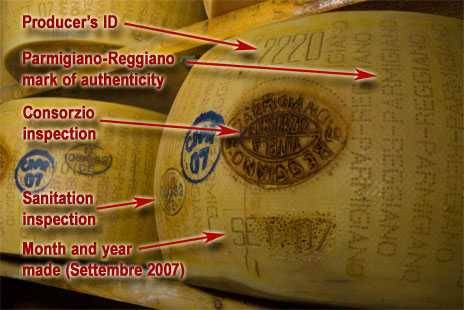
According to Faith Willinger, a Florence-based food writer, cookbook author, and teacher of renown, beginning in 1991 the Notari Dairy began switching to the red cow, an heirloom breed. Willinger raves over their cheese, calling it “Italy’s greatest Parmigiano. The secret is that Reggiana milk has more casein, so it holds more butterfat, resulting in a richer, big-flavored cheese that’s almost youthful at the standard two years and capable of aging far longer than those made with other milks.”
Notari’s cheese bears the producer identification code 101, a number not always visible, and, alas, you are not likely to find it in the US. But if you’re in the neighborhood, you can buy it at the dairy: Caseificio Notari, Istituto Agrario A Zanelli, via Fratelli Roselli, Reggio nell’Emilia, phone 39-0522-321-344.
A very nice Parmigiano Reggiano from vacche rosse made by Villa Sabbione near Reggio Emilia can occasionally be found online. For my money, age is more important than breed of cow, but if all else is equal, try the vacche rosse.
Serving and cooking with Parmigiano-Reggiano
In an interview in TIME magazine Chef Mario Batali said that in his many Iron Chef competitions on the Food Network, “I think my favorite secret ingredient was Parmigiano-Reggiano. The potential for that ingredient is infinite.” Here are a few of the things you can do with this wonderful cheese.
As an appetizer. Eating Parmigiano-Reggiano chunks is superb eating all alone as an appetizer, especially as it passes the 24 month age. It goes well with olives, nuts, marinated mushrooms, sausage, and a whole range of anti-pasti. Serve it straight and drizzled with a high quality aged balsamic vinegar. Slivers of this salty cheese draped on slices of pear make a great foil for the sweetness.
Grated on cold dishes. Parmigiano-Reggiano is hard enough for shredding and grating into fine powders for sprinkling on cold dishes such as salads, especially Caesar salads, and carpaccio.
Mixed in hot dishes. Parmigiano-Reggiano melts well and adds depth and richness when sprinkled on hot dishes such as pastas, soups, stews, risotto, polenta, and grits.
As a crust. It also makes a crunchy-chewy crust when grated and melted on casseroles, crostini, or pizza.
Pa-pa-pa-pa-parmigiano, Re-re-re-re-re-reggiano…
Parmigiano-Reggiano has built its brand in Italy with a series of clever, humorous, occasionally hysterically funny, TV commercials and a theme song that is sure to stick in your brain all day. Below are excerpts from a recent campaign.
Hard times for hard cheese?
Right about the time the world was bailing out its banks in December 2008, the Italian government stepped in to help the producers of Parmiggiano-Reggiano. According to a story in the Wall Street Journal on 12/10/2008, the Italian government has bought 100,000 wheels of Parmigiano-Reggiano and donated them to charity. The article quoted one producer who claimed the market price for his cheese is ó7.4 a kilogram but it costs him ó8 a kilo to produce the cheese.
“There was a need for market intervention just as there was for banks,” said Luca Zaia, minister of agriculture in the center-right Berlusconi government.
The article attributes the financial crisis to fragmentation of production. With about 450 independent producers, they have little leverage in negotiating prices. Competition from Grana Padano, a similar cheese that costs less, is also a factor.
Mind the rind
Parmigiano-Reggiano has a natural rind. It is pure cheese. No wax or other coating.
The center part of the cheese shaves into slivers or grates easily, and as you get closer to the hard rind it is easier to grate into a fine powder. Problem is the rind can get very very hard. Grating it almost guarantees scraped knuckles.
But don’t throw it away. It is crammed full of goodness. In fact, once you realize what the rind’s potential is, you’ll be asking your cheese store if they have any rinds. Many sell them inexpensively. Here are some things to do with the rind.
1) Italians toss a chunk in soups, stews, tomato sauces, and beans where it exudes goodness into the liquid and melts into a yummy gooey hunk that surprises you when you get to the bottom of the bowl.
2) My favorite use for the rind is to grill it, a technique taught to me by Cristina Clerici of the Consorzio del Formaggio Parmiggiano-Reggiano, the regulatory and promotional agency for the producers. That’s right, just toss it on the grill. After about 10 minutes per side on medium heat it will soften enough to be cut with a knife easily and makes the most amazing grilled cheese sandwich when a warm chewy chunk is placed on a slice of crusty bread. Perhaps with a good mustard. Or eat it straight. This also works under a broiler.
3) Place it on a plate in the microwave for about 60 seconds. It bubbles and transforms into the most flavorful Cheetos imaginable. Play with the timing. Too long and it can get cardboardy.
4) If you have a smoker, throw it in there for half an hour at about 300°F. And don’t worry, it won’t burn or fall through the grates.

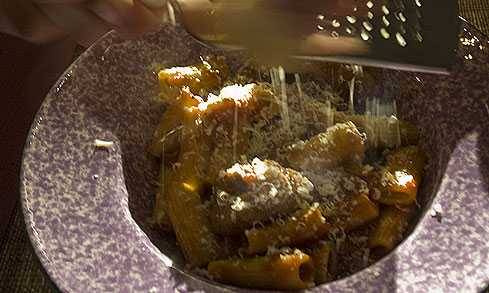

High quality websites are expensive to run. If you help us, we’ll pay you back bigtime with an ad-free experience and a lot of freebies!
Millions come to AmazingRibs.com every month for high quality tested recipes, tips on technique, science, mythbusting, product reviews, and inspiration. But it is expensive to run a website with more than 2,000 pages and we don’t have a big corporate partner to subsidize us.
Our most important source of sustenance is people who join our Pitmaster Club. But please don’t think of it as a donation. Members get MANY great benefits. We block all third-party ads, we give members free ebooks, magazines, interviews, webinars, more recipes, a monthly sweepstakes with prizes worth up to $2,000, discounts on products, and best of all a community of like-minded cooks free of flame wars. Click below to see all the benefits, take a free 30 day trial, and help keep this site alive.
Post comments and questions below
1) Please try the search box at the top of every page before you ask for help.
2) Try to post your question to the appropriate page.
3) Tell us everything we need to know to help such as the type of cooker and thermometer. Dial thermometers are often off by as much as 50°F so if you are not using a good digital thermometer we probably can’t help you with time and temp questions. Please read this article about thermometers.
4) If you are a member of the Pitmaster Club, your comments login is probably different.
5) Posts with links in them may not appear immediately.
Moderators